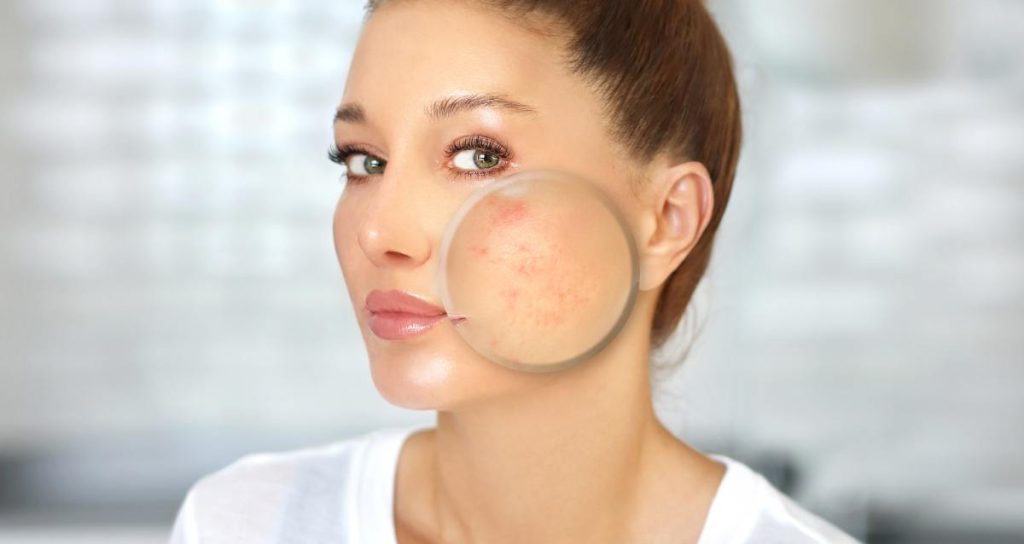Acne Marks vs. Acne Scars: Understanding The Differences

CONTENTS
ToggleIf you’re working towards clear skin, it’s important to know whether you’re dealing with acne marks or acne scars. This isn’t just about words – it’s about what they mean for your skin. Both come from past acne, but they’re quite different when it comes to treatment. Understanding these differences can help you choose the right treatment, and knowing which is which can set you on the right path to clear skin.
What are Acne Marks?
Acne marks, also known as post-inflammatory hyperpigmentation (PIH), appear as flat, discoloured patches on the skin following the resolution of an acne lesion. These marks are the skin’s natural response to the inflammation caused by acne and involve an overproduction of melanin, the pigment that gives skin its colour.
While they are generally a temporary issue, the duration they remain visible can vary, sometimes lasting several weeks or months. Unlike scars, these marks don’t affect the texture of the skin, and their intensity can fluctuate with factors like sun exposure and skin care practices.

Image via Anna Nekrashevich on Pexels

Image via cottonbro studio on Pexels
What are Acne Scars?
Acne scars are the result of more significant damage to the skin’s structure and are typically permanent without intervention. These scars can be atrophic, presenting as depressions or pits where the skin has lost collagen, or hypertrophic, which are raised and stand above the skin’s surface due to excess collagen during the healing process.
Their formation is often due to severe or untreated acne, skin picking, or genetic factors that affect how the skin heals. Because of their depth and the way they form, acne scars usually require treatments that go beyond the skin’s surface, such as laser therapy or surgical procedures, to improve the skin’s appearance and texture.
Treatment for Acne Marks
Acne marks, while not permanent like scars, can still be a source of distress. Treatments are designed to address the pigmentation issues caused by acne without causing additional damage to the skin. The objective with these treatments is not just to fade the marks, but also to promote skin health and prevent recurrence.
Pico Toning
Pico Toning stands out for its precision and speed. The treatment uses lasers that emit energy in picoseconds, which is one trillionth of a second, to fragment the melanin particles without thermal damage to the skin. This rapid pulse creates a photoacoustic effect that safely shatters pigment, allowing the body to flush out the fragments, leading to a reduction in the appearance of acne marks. This method is preferred for its efficacy and reduced downtime, making it a suitable option for those with busy lifestyles.
Treatment for Acne Scars
Acne scars are the result of deep tissue damage and require treatments that can reach beneath the skin’s surface to promote repair and rejuvenation.
Microneedle RF
Microneedling leverages the skin’s ability to heal itself. The fine needles create controlled micro-injuries to the skin, prompting it to produce collagen and elastin. Over several sessions, this can lead to a noticeable softening of scars and improved skin texture.
Fractional Pico Laser
Fractional Pico Laser treatment creates tiny columns of destruction in the skin, leaving the surrounding tissue intact for faster healing. This stimulates a natural healing process that rebuilds the skin, reducing the appearance of both shallow and deep scars.
CO2 Laser
The CO2 Laser is a powerful treatment option for acne scars, renowned for its effectiveness in skin resurfacing. It works by using focused laser energy to remove the top layers of damaged skin, thereby promoting the growth of new, healthy skin cells and increasing collagen production. This process effectively smooths out the texture of the skin, significantly reducing the appearance of both superficial and deeper acne scars. Its ability to precisely target scarred areas makes it a preferred choice for those looking to improve the overall texture and appearance of their skin after acne.
Subcision
Subcision is a specialised treatment targeting the fibrous bands that cause certain types of acne scars, particularly those that result in skin indentation. This procedure involves using a small needle to break these bands beneath the skin. By releasing these tethers, subcision allows the skin to lift and smooth out, diminishing the appearance of depressed scars.
Juvelook
Juvelook is an effective skin booster for treating acne scars. It differs from traditional fillers by targeting skin hydration and elasticity. This approach helps fill scar indentations and improves skin texture. The hyaluronic acid in Juvelook not only increases skin volume but also enhances long-term skin health. This makes Juvederm a preferred, non-surgical choice for those looking to reduce acne scars and improve their skin’s overall appearance.
How to Prevent Acne Marks and Scars
Preventing acne marks and scars is most effective with early and professional treatment. At Glowwis Aesthetic & Medical Clinic, the focus is on providing tailored treatments that nip potential scarring in the bud. The clinic’s specialists can offer comprehensive care, from managing active acne to suggesting preventive protocols, ensuring your skin gets the expert attention it deserves. Booking a consultation can be your first step towards a proactive skincare regimen, designed to keep your skin clear and reduce the risk of long-term damage.

Image via Polina Tankilevitch on Pexels
Conclusion
In conclusion, discerning the difference between acne marks and scars is a crucial aspect of achieving and maintaining clear skin. Professional treatments, like those offered at Glowwis Aesthetic & Medical Clinic, provide a bespoke approach to not only treat existing skin issues but also to prevent future ones. With the right expert care, the journey to clear, healthy skin can be smooth and well-guided, leaving you with confidence in your skin’s appearance.